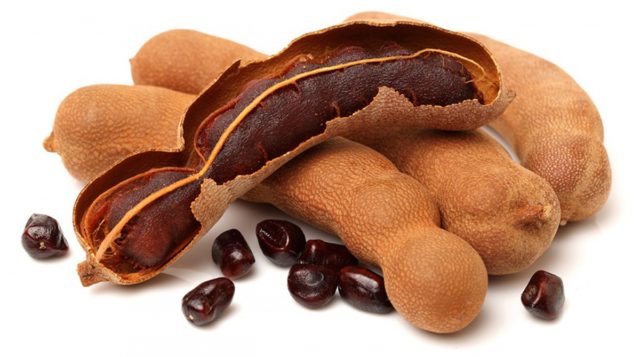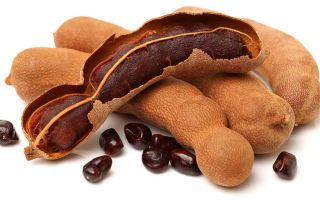Content
- 1 What is and what fresh tamarind looks like
- 2 The composition and calorie content of tamarind
- 3 How tamarind tastes and looks like
- 4 Why is tamarind useful?
- 5 How to eat raw tamarind fruit
- 6 Is tamarind possible for children
- 7 Do tamarind bones eat
- 8 The use of tamarind in cooking
- 9 Tamarind in cosmetology
- 10 Contraindications
- 11 How to choose and store tamarind
- 12 Conclusion
- 13 Tamarind reviews
Knowing how to eat tamarind correctly is necessary to appreciate the taste and get the most out of the fruit. It belongs to the legume family and is the only representative of the Tamarind genus. The specified fruit is better known as the Indian date.
What is and how does fresh tamarind look like?
Tamarind are brown beans. They grow in length up to 20 cm, in width - up to 2-3 cm. Fruits ripen on trees of the same name, which can reach 20 m in height and 9 m in diameter.
The crown of the plant is spreading, lush. Like other trees growing in the tropics, tamarind are evergreen. But they bear fruit only once a year.
Pointed pods form in large numbers on tree branches. From above, they are covered with a fragile skin of an earthy hue. Fruits are harvested from January to February, but in some regions they reach maturity at the end of December. An Indian date is considered fully ripe when the beans are easily separated from the branches of the tree.

The composition and calorie content of tamarind
The pulp of Indian dates is high in fiber and carbohydrates. Calorie content per 100 grams - 239 kcal. It includes:
- 2.8 g protein;
- 0.6 g fat;
- 57.4 g carbohydrates;
- 5.1 g dietary fiber;
- 2.7 g of ash.
The fruit pulp contains unsaturated fatty acids, mono- and disaccharides. Tamarind is a great source of vitamins. The beans contain:
- vitamins A, C, E, K, PP, group B (thiamine, pyridoxine, choline, riboflavin, folic, nicotinic and pantothenic acids);
- beta carotene.
When using tamarind, minerals enter the body:
- selenium;
- copper;
- zinc;
- iron;
- phosphorus;
- potassium;
- magnesium;
- sodium;
- calcium.
All vitamins and elements are necessary for the normalization of the body. Choline, for example, is involved in metabolic processes. Without nicotinic acid, the process of assimilation of phosphorus, calcium, magnesium is hampered. Also contains tamarind lactic, tartaric and hydroxycitric acids.
How tamarind tastes and looks like
The fruits of Indian dates look like elongated peanut pods. The peel of tamarind is firm, even, slightly rough to the touch. There is an elastic flesh under it. In consistency, it is similar to oriental sweets - baklava or churchkhela.
Green tamarind has a sour flesh. It is used in the preparation of spicy dishes. When ripe, the pulp acquires a pleasant sweet and sour fruity taste. Compared to common dates, tamarind is more sour. When the fruit is cut, the sweet aroma is immediately felt.
The color of the ripe pulp is chocolate, with a shade of red.From the inside, it attaches to the peel using filamentous processes.
There are hard bones in the pulp of the tamarind fruit; outwardly, they resemble small smooth dark brown stones. Each fruit contains 5-7 seeds. The bones, rind and filamentous processes are inedible.

Why is tamarind useful?
The fruits of the Indian date saturate the human body with the necessary vitamins and minerals. They have the following actions:
- bactericidal;
- anti-inflammatory;
- antioxidant;
- astringent;
- hemostatic;
- immunostimulating;
- laxative.
Tamarind is used as a means to normalize the functioning of the gastrointestinal tract, reduce gas formation. In folk medicine of eastern countries, fruits are used to treat diseases of the digestive system. The substances contained in Indian dates normalize the state of the gastrointestinal tract, promote the removal of toxins and toxins.
The beneficial properties of tamarind are due to its composition:
- vitamin B4 (choline) takes part in the metabolism and is necessary for the proper functioning of the brain, kidneys, liver;
- ascorbic acid and tocopherol act as an antioxidant, help to cope with increased mental and physical stress, ridding the body of free radicals;
- B vitamins prevent the development of nervous disorders;
- potassium ensures the normal functioning of the heart, blood vessels, muscles;
- phosphorus and calcium are responsible for the structure and density of bone tissue;
- magnesium is involved in metabolism, regulates body temperature;
- sodium is necessary to normalize the water-salt balance.
Including fruit in the diet is recommended for people of all ages. Not only fruits are useful, but also other parts of the plant. They are used for the preparation of infusions, decoctions.
For women
The pulp of the Indian date is good for women's health. It is recommended to eat tamarind for hormonal disorders. It is advised to patients suffering from infertility. The inclusion of fruits in the diet helps prevent anemia or normalize the condition with a slight decrease in hemoglobin in the blood.
Also, the use of fruit helps to increase the sensitivity of the erogenous zones. It is considered a female aphrodisiac. Under the influence of the substances contained in it, sexual desire is enhanced.
Tamarind is not contraindicated during pregnancy. But you shouldn't abuse it.

For men
Men should pay attention to the Indian date, as a fruit that normalizes the work of the heart, blood vessels, and promotes the removal of "bad" cholesterol. The acidic potassium salt included in the composition has a diuretic and laxative effect, thanks to this it is possible to normalize blood pressure.
The benefits of tamarind for men are not limited to the positive effects on the heart and blood vessels. The substances that make up the fruits normalize the functioning of the organs of the genitourinary system and increase sexual desire.
When losing weight
Tamarind contains a large amount of fiber. It contributes to the appearance of a feeling of fullness, a decrease in appetite. Polyphenols, flavonoids and hydroxy acids have a similar effect.
Hydroxycitric acid, which is part of the pulp, is a fat burner. It blocks the transition of glucose into body fat when it enters the body. This effect is achieved through inhibition of amylase.
They eat tamarind for weight loss as a means that improves digestion and has a laxative effect. It also accelerates the breakdown of fat and normalizes the absorption of nutrients.
How to eat raw tamarind fruit
Tamarind is consumed fresh. But you can use fruits for making desserts, sauces, snacks, drinks.
To taste the fruit, you need to remove the pulp from the rind. To do this, the outer shell is cut lengthwise with an ordinary knife and broken into 2 parts. After that, the pulp is easy to remove. Before use, it is advisable to remove the filamentous processes and seeds.
Is tamarind possible for children
Indian dates are allowed to be included in the diet of children. They have immunostimulating, antimicrobial and anthelmintic effects on the body. It is also given to children suffering from constipation and other digestive disorders. It works as a mild laxative and helps cleanse the body.
For babies who live in regions where tamarind grows, fruits are added to the diet from an early age. For children for whom this fruit is exotic, it is better to include it in the diet no earlier than 7-8 years old. Indian dates should be added to the menu with caution, observing the reaction of the body. They can trigger the development of allergies.
Do tamarind bones eat
Indian date seeds are considered inedible, so they are recommended to be extracted from the pulp. But you don't have to throw them away. Tamarind bones are used in cosmetology. They make a decoction for external use. It moisturizes the skin and promotes its rejuvenation.

The use of tamarind in cooking
Indian dates are eaten not only fresh, but also used for cooking. On the basis of tamarind they make:
- Dessert;
- sauces;
- pastes;
- candy;
- jams;
- beverages;
- salads.
For sweet dishes, ripe fruits are needed. They are used to add a savory sweet and sour flavor to desserts or baked goods.
Unripe fruits are used to prepare sauces for meat, fish, vegetables. They are added to dressings for salads and soups. To make a popular tamarind sauce for seafood and fish, follow this description:
- chili peppers, garlic, onions and ginger should be fried in olive oil for 3-4 minutes;
- after the appearance of the smell, add the chopped pulp of the Indian date without hard fibers and seeds;
- hold the mixture over low heat for 2-3 minutes so that the tamarind is saturated with aromas;
- pour in 1 tbsp. Thai fish and 1 tsp. oyster sauce, water;
- salt, add sugar.
The sauce should taste spicy, spicy-sweet. Its density is adjusted by adding water. They can be poured over prepared fish or seafood.
Pregnant women are advised to consume tamarind dishes in limited quantities. Substances contained in the fruit can lead to indigestion or cause bleeding to open.
Tamarind in cosmetology
In Eastern countries, SPA procedures are popular in which the pulp of Indian dates is used. It moisturizes the skin and nourishes it with nutrients. Cleansing lotions are made from the fruit extract. Tamarind water is used in many oriental SPA-salons as a tonic and moisturizer for the skin.
At home, face masks can be made from the pulp of Indian dates. The organic acids included in their composition reduce the severity of inflammatory processes on the skin, contribute to the regeneration of the epidermis, cell renewal and the elimination of toxins.

Contraindications
Not everyone can include Indian dates in their diet. Before use, the health benefits and harms of tamarind should be assessed. Caution should be exercised by people who:
- diabetes;
- exacerbation of diseases of the digestive tract;
- diarrhea;
- allergy.
Due to its high carbohydrate content, eating tamarind can trigger a spike in blood glucose levels. In patients with gastritis, erosive and ulcerative diseases of the digestive system, fruit acids will lead to a worsening of the condition. With diarrhea, the inclusion in the diet of foods that have a laxative effect is contraindicated. This can lead to dehydration.
This is not a complete list of contraindications to the use of tamarind. It is not recommended for patients taking anticoagulants. The substances contained in the fruit thin the blood. This combination can lead to the opening of bleeding.
How to choose and store tamarind
When planning to buy fresh tamarind, you need to pay attention to fruits with an even, hard skin without visible damage. The appearance of wrinkling indicates that the fruit is spoiled.
The fruit has a short shelf life. Unpeeled, ripe beans can sit in the refrigerator for about 1 to 2 weeks. At room temperature, they will start to deteriorate after 2-3 days. You can increase the shelf life by storing the fruit in the freezer.
Conclusion
Learning to eat tamarind properly is easy. The fruit must be peeled, removed from the hard fibers and seeds. The pulp can be eaten fresh or added to various dishes. Despite the benefits of fruits, it is advisable to include them in the diet in small quantities.
Tamarind reviews

